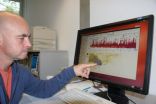(Press-News.org) This news release is available in German.
When it comes to defence against viruses, the immune system has an arsenal of weapons at its disposal including killer cells, antibodies and messenger molecules, to name just a few. When a pathogen attacks the body, the immune system usually activates the appropriate mechanisms. However, some of the mechanisms do not have to be triggered; they are continuously active as a standing army. Researchers from ETH Zurich, in collaboration with scientists from the University of Bern, have now discovered a new form of this so-called innate immune defence. They have shown that it acts against particular viruses with a genome in the form of single-stranded, positive-sense RNA. Many known pathogens, such as hepatitis C, tick-borne encephalitis, polio, SARS, yellow fever and dengue fever viruses belong to this group, as well as potyviruses, a group of plant viruses that can cause severe damage to economically important crops.
Researchers led by Ari Helenius, Professor of Biochemistry at ETH Zurich, discovered the mechanism during their research with human cells in cell culture and a model virus that is frequently used in basic research, the Semliki Forest virus. In an extensive screening process, the scientists turned off individual genes inside host cells; they discovered that the cells were more susceptible to infection by the virus if the genes of a cellular quality control and regulatory system for RNA, known as NMD (nonsense-mediated mRNA decay), were turned off.
Viruses identified as incorrect cellular RNA
In a parallel large-scale screening effort, Olivier Voinnet, Professor of RNA Biology at ETH Zurich, and his colleagues realised that this mechanism is also acting against viruses in plants. They used the model plant Arabidopsis thaliana and potato virus X for their investigation. Helenius and Voinnet's groups have published their two research papers on human cells and plants in the latest edition of the journal Cell Host & Microbe – the former in collaboration with the group of Oliver Mühlemann, a professor at the University of Bern, who has dealt intensively with the NMD system in recent years.
The NMD system has been known for some time in biology as a quality control and regulatory mechanism that eliminates incorrectly fabricated and non-functional messenger RNA molecules in cells. However, the new studies show that this system also serves a second function: It ensures that the genome of certain RNA viruses is broken down, thereby preventing them from replicating in host cells. "The RNA genome of these viruses bears certain similarities to incorrect messenger RNA molecules in human, animal and plant cells and is identified as such by the NMD system," explains Giuseppe Balistreri, post-doctoral fellow and lead author of one of the two studies.
Oldest defence mechanism
The researchers believe that the NMD system provides a first line of defence against infection by this class of viruses. "The mechanism attacks the viral genome directly before it can multiply in the host cell," say both Helenius and Voinnet. The ETH scientists also believe that this is one of the oldest defence mechanisms against viruses in evolutionary history, as the NMD system is so fundamental that it is found in all higher organisms; i.e. people, animals, plants and fungi.
However, the mechanism is not 100 per cent efficient. "If it were, then RNA viruses wouldn't exist at all," says Helenius. Instead, the viruses have evolved ways to avoid or actively suppress the NMD system, as both ETH research groups suggest in their respective studies. "Viruses and their hosts are engaged in an endless battle, of which the NMD system is a previously unsuspected yet significant component," says Voinnet. "In this battle, the NMD mechanism likely contributed to shape the genomes of RNA viruses as we see them today."
NCCR RNA & Disease
The two research projects were carried out within the National Centre for Competence in Research (NCCR) RNA & Disease. Sixteen research groups from five Swiss universities are working together in this focus area of the Swiss National Science Foundation. They are studying the role of RNA biology in diseases. The University of Bern is the NCCR's leading house and ETH Zurich is the co-leading house.
INFORMATION:
Literature reference
Balistreri G, Horvath P, Schweingruber C, Zünd D, McInerney G, Merits A, Mühlemann O, Azzalin C, Helenius A: The Host Nonsense-Mediated mRNA Decay Pathway Restrics Mammalian RNA Virus Replication. Cell Host & Microbe 2014, 16: 403-411, doi: 10.1016/j.chom.2014.08.007 [http://dx.doi.org/10.1016/j.chom.2014.08.007]
Garcia D, Garcia S, Voinnet O: Nonsense-Mediated Decay Serves as a General Virus Restriction Mechanism in Plants. Cell Host & Microbe, Online publication 21 August 2014, doi: 10.1016/j.chom.2014.08.001 [http://dx.doi.org/10.1016/j.chom.2014.08.001]
New defense mechanism against viruses discovered
2014-09-11
ELSE PRESS RELEASES FROM THIS DATE:
UM research reveals secrets of animal weapons
2014-09-11
MISSOULA – From antlers to horns, humans have long been fascinated by animals' ability to defend themselves with their natural-born weapons. But until now, no studies have directly tested whether those weapons perform better at the animals' own style of fighting than they would using the fighting style of another species. Researchers at the University of Montana recently discovered each species' weapons are structurally adapted to meet their own functional demands of fighting.
The groundbreaking research, conducted over the past year by UM doctoral student Erin McCullough ...
Excitonic dark states shed light on TMDC atomic layers
2014-09-11
A team of Berkeley Lab researchers believes it has uncovered the secret behind the unusual optoelectronic properties of single atomic layers of transition metal dichalcogenide (TMDC) materials, the two-dimensional semiconductors that hold great promise for nanoelectronic and photonic applications.
Using two-photon excitation spectroscopy, the researchers probed monolayers of tungsten disulfide, one of the most promising of 2D materials, and found evidence for the existence of excitonic dark states – energy states in which single photons can be neither absorbed nor emitted. ...
Cutting health-care costs 1 appendix at a time
2014-09-11
(SALT LAKE CITY)—Consumer price comparison is almost nonexistent in the U.S. health care system, but a new study shows that when given the choice between a less costly "open" operation or a pricier laparoscopy for their children's appendicitis, parents were almost twice as likely to choose the less expensive procedure – when they were aware of the cost difference.
The study, published in the September issue of Annals of Surgery online, shows that providing pricing information upfront can influence patient choice of surgical procedures and potentially lead to cost savings ...
Endometriosis a burden on women's lives
2014-09-11
Endometriosis often takes a long time to be diagnosed and affects all areas of a women's life, a study has found.
Research led by Monash University's Kate Young published in the Journal of Family Planning and Reproductive Health Care found that endometriosis affects women's sex lives, personal relationships, work life, and emotional wellbeing.
Endometriosis is a chronic, recurring disease that is experienced by approximately 10 per cent of women worldwide. Common symptoms include painful menstruation, heavy menstrual bleeding, painful sex and infertility.
Ms Young, ...
Perfect focus through thick layers may bring better vision to medicine
2014-09-11
WASHINGTON, Sept. 11, 2014—Zooming in on diseased tissue or scanning fragile biological samples are essential tools in medicine and biological research, but this often requires peering through layers of tissue and other materials that can blur and distort the image. Certain modern microscopes can compensate for this, but only for weak aberrations or by using invasive "guide stars," imaging aids that provide a stable reference point.
In a first-of-its-kind demonstration, published today in The Optical Society's (OSA) new high-impact journal Optica, a team of researchers ...
The ozone hole has stabilized -- some questions remain
2014-09-11
After the detection of the ozone-depleting properties of CFCs in the 1970s, data from satellite measurements in 1985 startled mankind. A huge hole had been discovered over the Antarctic in the ozone layer that protects the Earth from dangerous, carcinogenic UV rays. Already in 1987 politicians around the world reached agreement on the Montreal Protocol that bans ozone-depleting substances, in particular chlorofluorocarbons (CFCs). 197 states have now ratified this international treaty. A series of scientific expert reports has since accompanied the efforts to save the ozone ...
Crop improvement and resistance to pathogens benefits from non-coding RNA studies
2014-09-11
With the rise of emerging economies around the world and a concomitant upgrade of health care systems, the global population has been rapidly expanding. As a consequence, worldwide demand for agricultural products is also growing.
Crops now provide food and the other important resources for seven billion humans.
Food supplies are primarily based on such crops as wheat, maize, rice and vegetables. But as the area of arable land and of cultivated land continues to decline, the future ability to meet the world's food security needs has come under a cloud of uncertainty.
Meanwhile, ...
Last decade's slow-down in global warming enhanced by an unusual climate anomaly
2014-09-11
A hiatus in global warming ongoing since 2001 is due to a combination of a natural cooling phase, known as multidecadal variability (MDV) and a downturn of the secular warming trend. The exact causes of the latter, unique in the entire observational record going back to 1850, are still to be identified, according to an article by the European Commission's Joint Research Centre (JRC).
The earth hasn't warmed at the same pace during the 20th century. The noticeable temperature increases during some periods interspersed with fairly stable or decreasing levels during others ...
The quantum revolution is a step closer
2014-09-11
Theories show how computing devices that operate according to quantum mechanics can solve problems that conventional (classical) computers, including super computers, can never solve. These theories have been experimentally tested for small-scale quantum systems, but the world is waiting for the first definitive demonstration of a quantum device that beats a classical computer.
Now, researchers from the Centre for Quantum Photonics (CQP) at the University of Bristol together with collaborators from the University of Queensland (UQ) and Imperial College London have increased ...
VALUE study reports on accreditation status
2014-09-11
SEPTEMBER 2014 | Ellicott City, MD – The Intersocietal Accreditation Commission (IAC) announced today that researchers from the University of Miami Miller School of Medicine have published a manuscript in Vascular Medicine analyzing a random national sample of Medicare beneficiary data to determine the outpatient vascular testing facilities' accreditation status and geographic location. The study manuscript entitled, "Accreditation Status and Geographic Location of Outpatient Vascular Testing Facilities Among Medicare Beneficiaries: The VALUE (Vascular Accreditation, Location ...



